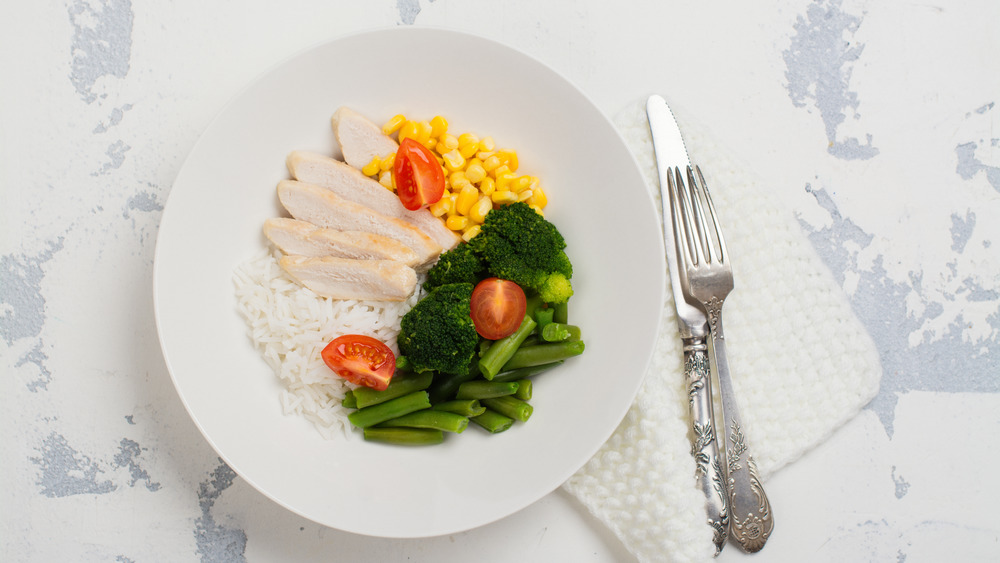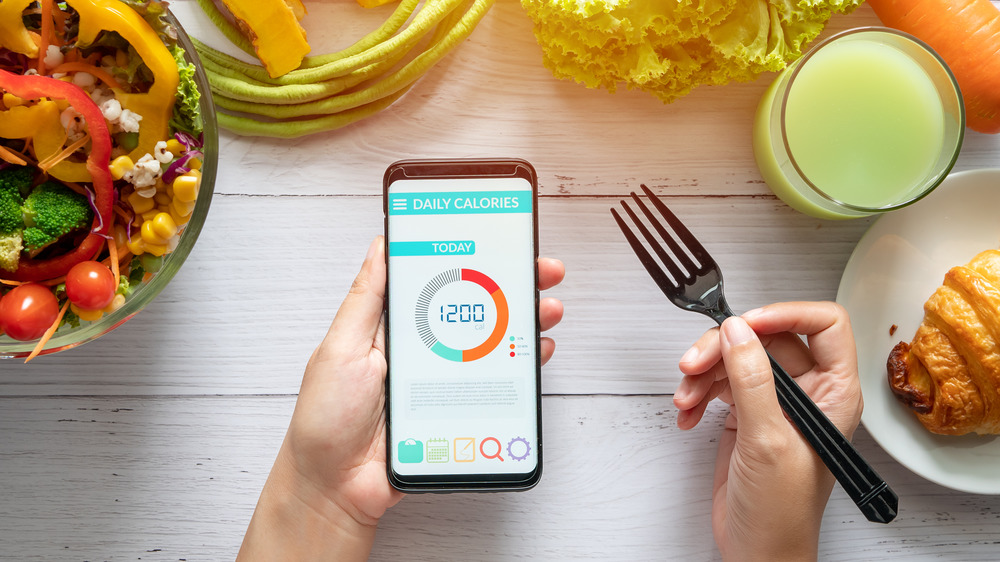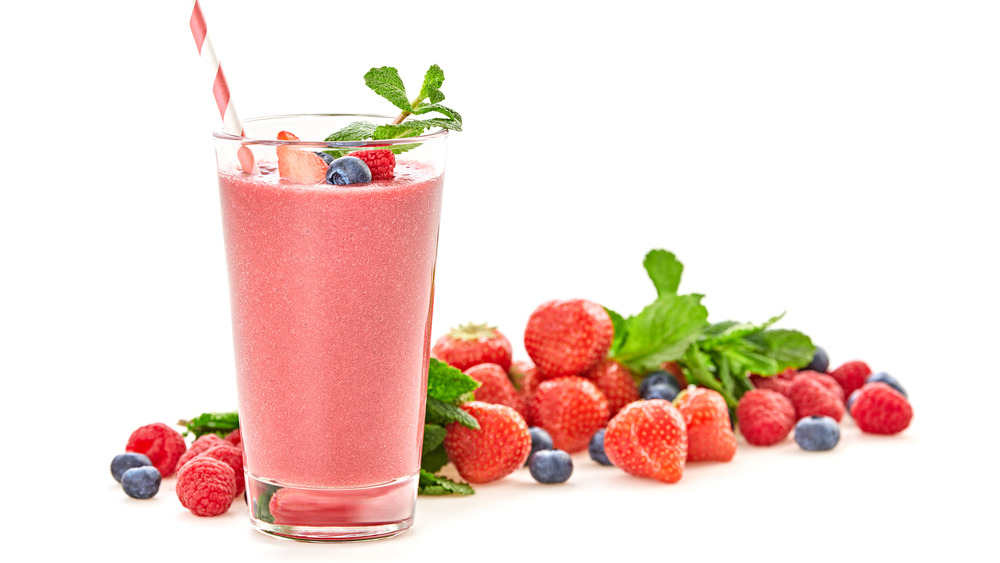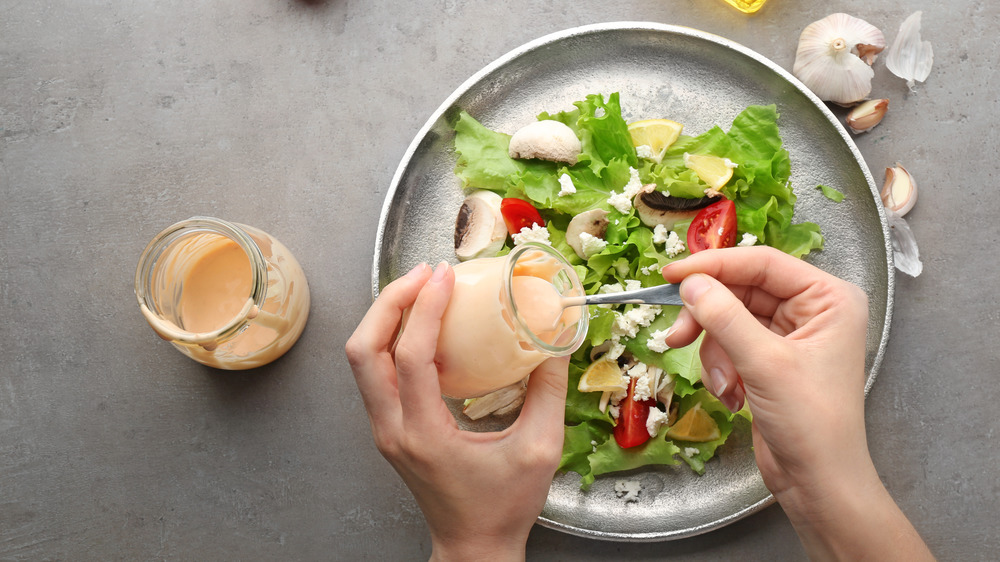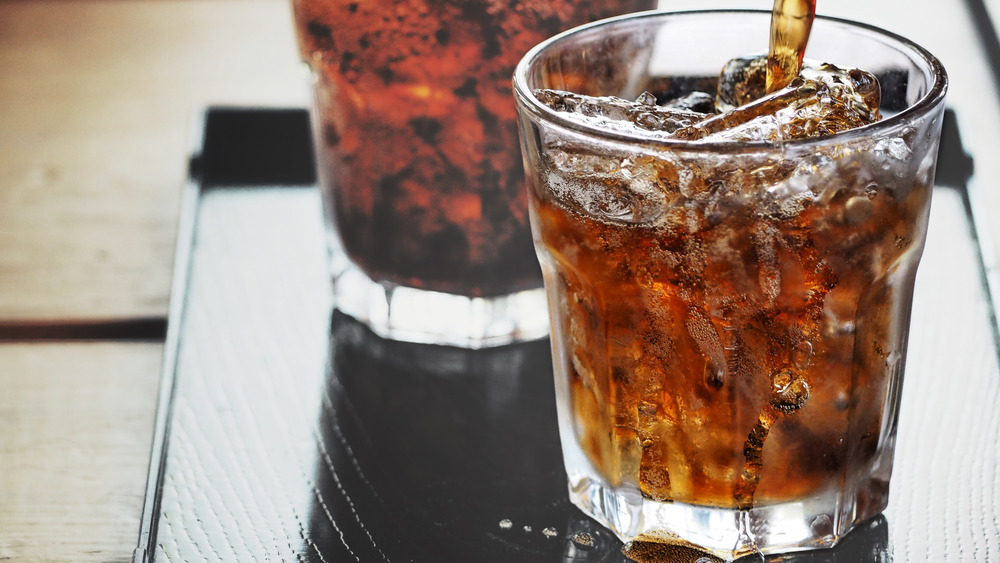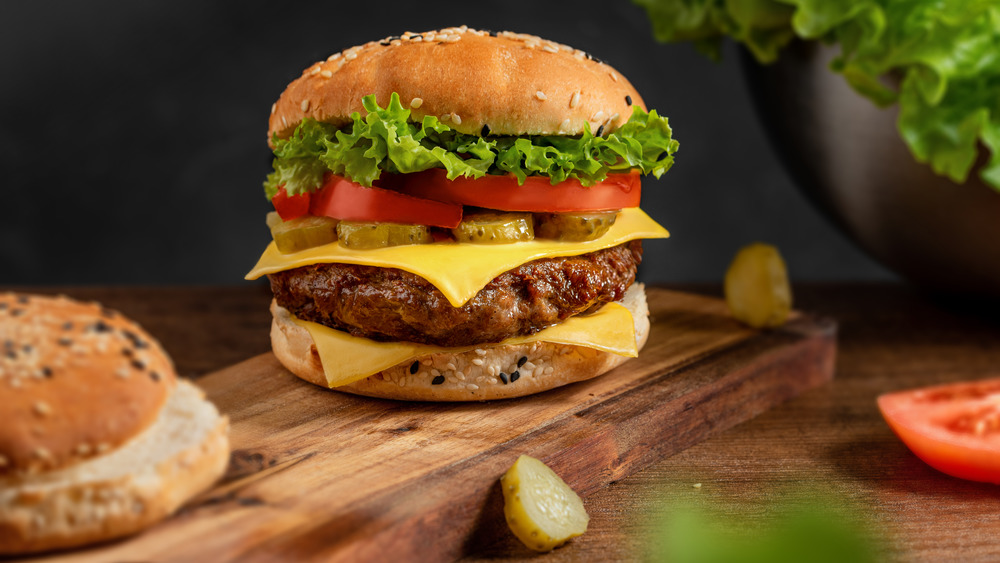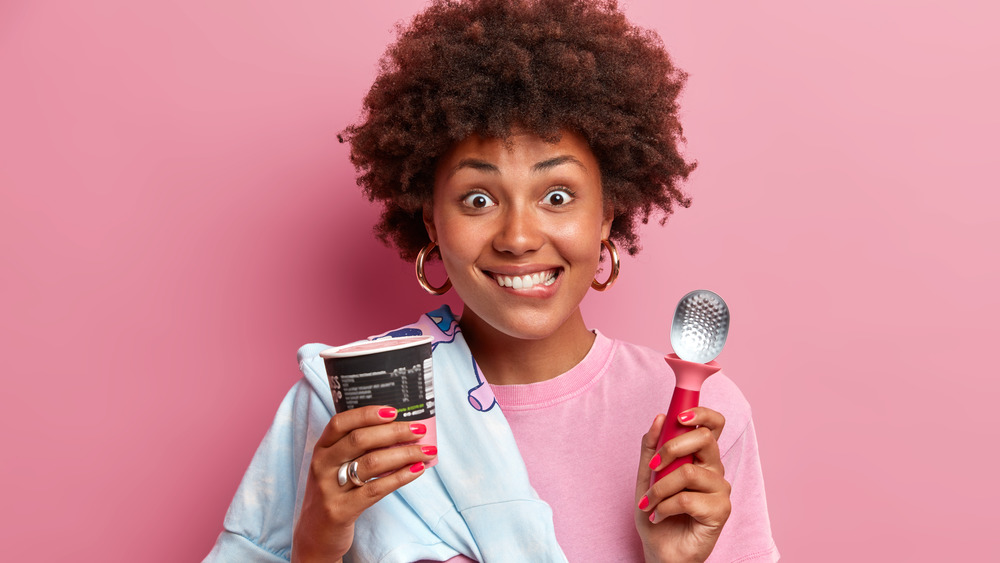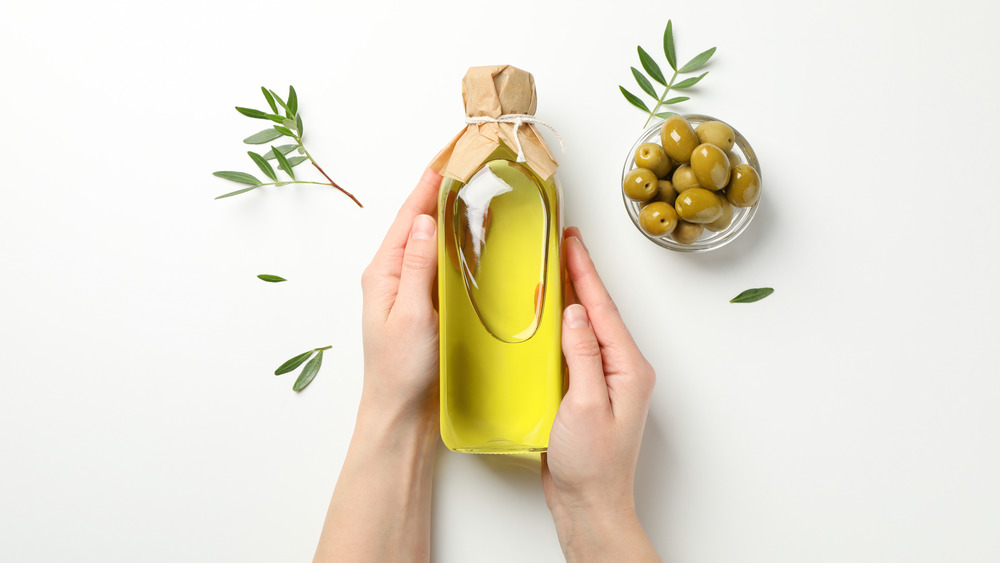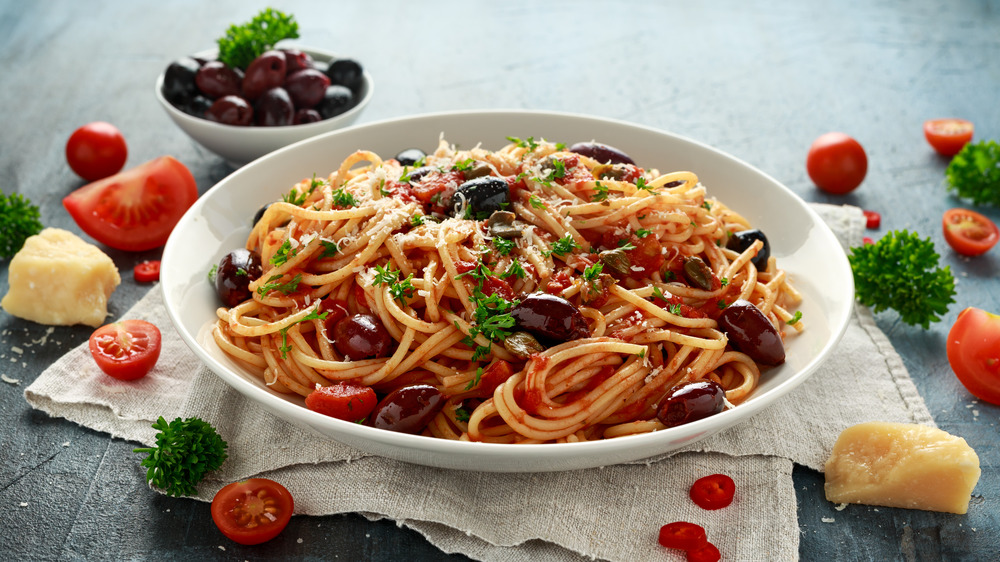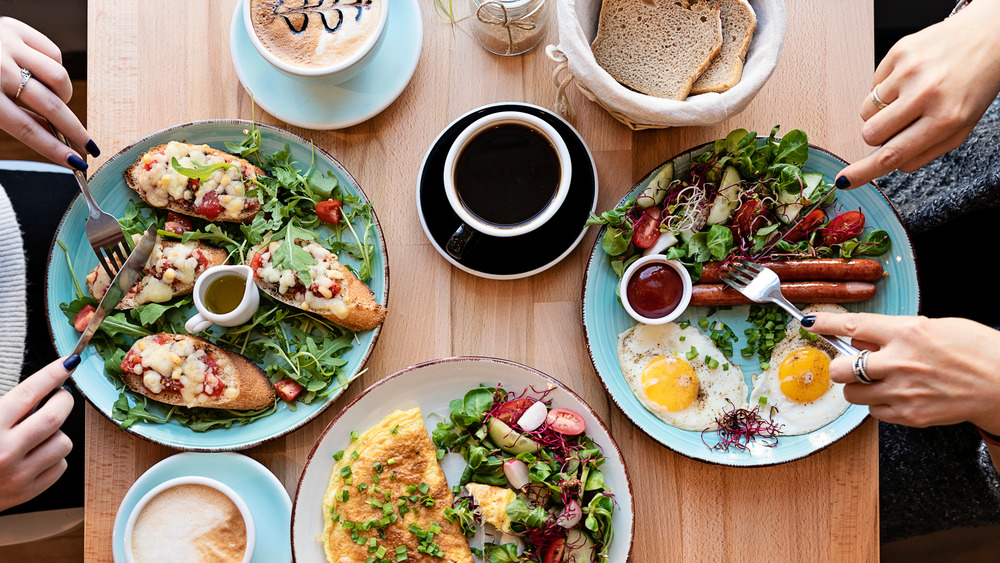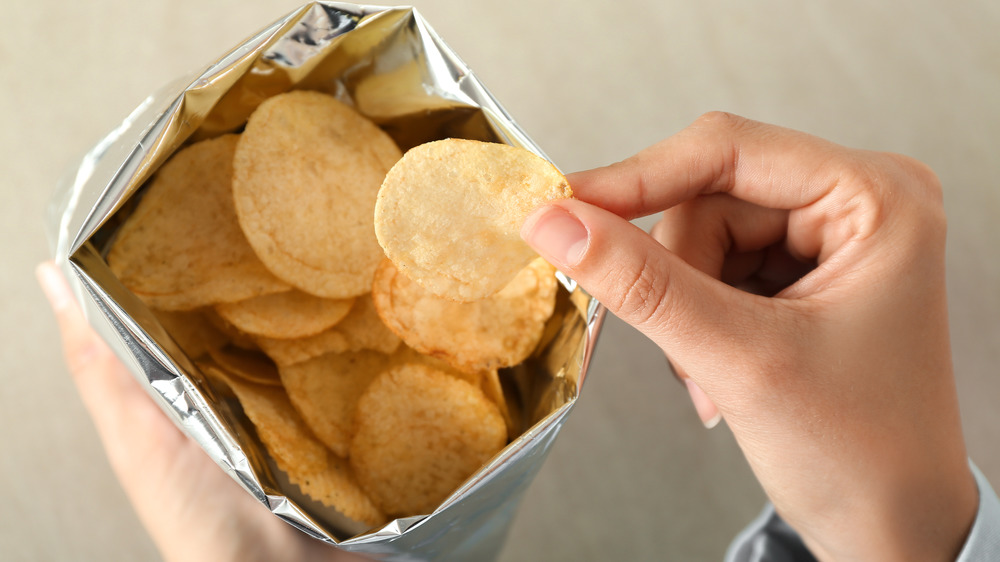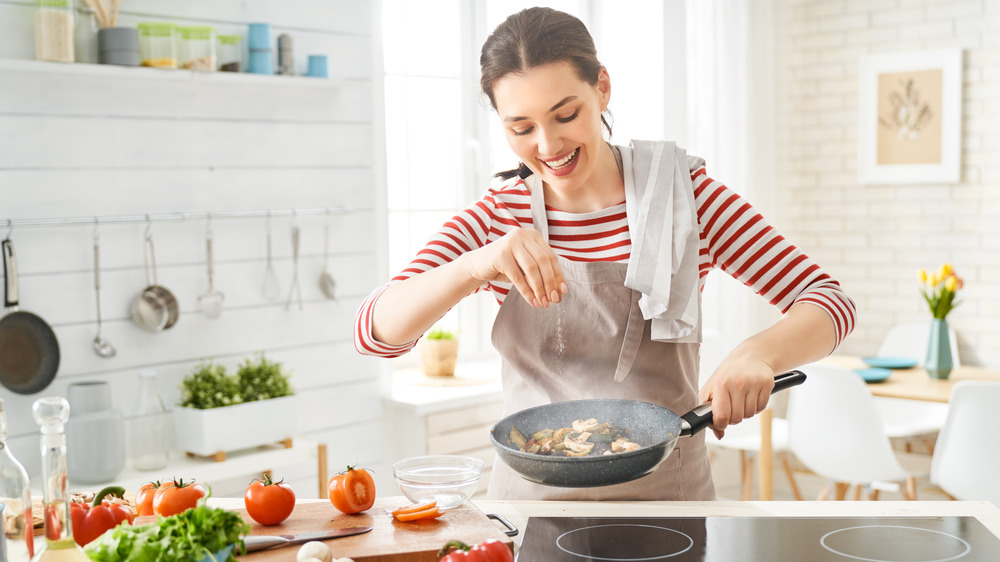The Biggest Mistakes You're Making With Portion Sizes
Portion control is key when you're on a mission to have a healthier diet. Whether your goal is to lose weight, improve your cholesterol, or just feel more energized, you can succeed without giving up your favorite fridge, freezer, and pantry must-haves. The key is rather simple, really: portion sizes and self-restraint.
This starts with reading labels, measuring ingredients, and learning to understand what a balanced plate actually looks like. Registered dietician Jennifer Maeng told LiveStrong that "we were all born with an innate ability to regulate hunger and satiety, and our bodies are capable of telling us how much to eat. But many of us have lost that connection with our bodies and now let our emotions, stress and portions determine how much we eat." In other words: stop before you shovel, and listen to your body. Better yet, follow the recommended serving sizes, and learn the common mistakes you might be making so that you can proactively correct them. In time, this will become more intuitive, and you'll gain a good grasp on how much you should be eating at each sitting. You've got this.
You're not measuring anything
If you are on a strict weight-loss diet, you are more likely to be strict about measuring portions. After all, creating a calorie deficit is the most effective way to lose those stubborn pounds. However, if you are just trying to live life, eat balanced meals, and be healthy, you are probably not thinking about using cup measures, tablespoons, and scales to determine how much of each food you actually need.
But the reality is: you may be eating way more than you should be. As noted by Kaiser Permanente, you can pare down your plate by ensuring that each meal consists of half vegetables, 1/4 lean protein, and 1/4 whole grains.
You could also learn more about exercising portion control by weighing your food with a kitchen scale. What's more, a nutrition and calorie-counting app can help you track your diet and gain a better understanding (via NBC News). No, you don't have to measure or weigh every single morsel that enters your mouth, but being more proactive in your approach can help give you more insight on how much you really are taking in versus how much you should be.
Your breakfast smoothie is big enough to serve two or more
That giant morning smoothie of yours might be loaded with all sorts of healthy eats, treats, and greens — antioxidant-rich berries, leafy spinach, soaked cashews, coconut oil, and dairy yogurt (delicious!). But while there are a plethora of vitamins, minerals, and nutrients, there is also an abundance of calories and sugar in your smoothie.
That doesn't mean you have to give up your a.m. smoothie. It just means you might want to share your blended carafe with a friend or two. As noted by Prevention, a large smoothie could have up to a full pound of produce — and you certainly wouldn't eat your way through that much if it was all raw. You don't have to cut down all the healthy fruits and veggies, just stick to an 8-ounce serving (have a designated smoothie glass!); you can re-freeze the extra blend to use later in the week.
You're not measuring that big bowl of cereal you pour
Cereal is certainly a convenient breakfast. All you have to do is pour it from the box, add milk, and grab a spoon — just like that, your morning meal is served.
Of course, while it might be an easy option, it is not necessarily a healthy or diet-friendly one. If you looked at the nutritional label of your favorite boxed brand, you would likely find that a serving size is a lot smaller than that big old bowl you just poured. In fact, Consumer Reports asked people to pour themselves their normal bowl of cereal, and 92 percent of them over-served. According to the report, "they helped themselves to 24 percent to 92 percent more when using a 12-ounce bowl and 43 percent to 114 percent more when using an 18-ounce bowl." So do yourself a favor next time you want to have some frosted corn flakes and measure it out — even if you decide to go back for seconds. It will give you a more accurate representation of the calories, carbs, and sugar you are actually consuming.
You are putting too much sugar and cream in your bottomless coffee cup
Do you chug coffee all day long? That bottomless cup of coffee of yours is loading you up with caffeine, but it can also be giving you a surprising amount of unhealthy extras. It all depends on how you take your java; if you like it light and sweet, then every time you refill, you pour in incremental cream, sugar, and calories. It might not seem like a lot, but it adds up.
As noted by Eat This, Not That!, every tablespoon of a flavored creamer has 5 grams of sugar. Plus, there are plenty of questionable additives in your lightening product of choice. What's more, the shelf-stable creamer options are loaded with synthetic ingredients you don't want to consume in excess. The same goes for artificial sweeteners. Flavored syrups add tons of calories and sugar, too. Basically, if you are going to be sipping on coffee all day long, keep it black — and maybe try some decaf for good measure.
You're being overly generous with salad dressing
Your salad looks like a health-food dream — all kale and spinach and mushrooms and colorful antioxidant-rich vegetables. Maybe you are making your lunch a little heartier with a serving of lean chicken breast, some hard-boiled eggs, a bit of grated cheese, and perhaps a few sprinkled seeds — nutritious and delicious.
Unfortunately, you could be undoing all that delightful vitamin and nutrient goodness when you glop on that rich, creamy, oily, and heavy dressing of yours. This is because most salad dressings call for a rather puny portion — just two measly tablespoons. And, as noted by VeryWell Fit, many common store-bought brands have up to 200-plus calories in that unsatisfying serving size. So if you neglect to measure and recklessly pour it on, you could be totally sabotaging your otherwise healthy salad. Fork that; if you want to keep it diet-friendly without eating dry lettuce, try some lemon juice or a drizzle of balsamic vinegar.
You're chugging way too much soda and not realizing it
That favorite cola you reach for is basically akin to drinking 12 fluid ounces of pure sugar. According to Coca-Cola, there are a whopping 39 grams of sugar in a single can of their beloved pop. And if you dare to have a second — or ask for a refill at your favorite restaurant, well, you'll be consuming a boatload of calories.
As recommended by the American Heart Association, men should strive to have no more than 36 grams of sugar per day, while women should aim for 25 grams or less. Meanwhile, soft drinks typically account for 25 percent of added sugar intake. If you don't want to give up your favorite fizzy drink, be mindful as you chug — and read the label. Some bottles may look like they're made for one person and one sitting but actually have multiple servings (via Rady Children's Hospital San Diego).
The same goes for all drinks — including wine. A single pour of vino is supposed to be just 5 ounces; if you have large glasses (and have had a long day), you're likely to be more generous with your (un)portioned pour (via Self).
That burger patty you're making is way too big
If burgers are your go-to barbecue meal of choice, or you can't resist a juicy slab of beef at a brewery or restaurant, you will want to be mindful of the patty size. A hamburger should be only two to three ounces, as per the American Heart Association. Furthermore, while a beefy double patty burger might make your mouth water, it certainly won't make you any healthier. In an interview with Today, registered dietitian Felicia Hackett explained that "years ago, when you would go to McDonald's the value meal was a cheeseburger. Now it's a double cheeseburger. It's become normal for us to eat those larger sizes."
While you are at it, skip the serving of French fries. Instead, have a hearty side of non-starchy fiber-loaded vegetables, such as brussels sprouts, carrots, or cauliflower. They are nutrient-dense and will help ensure that you are satisfied when meal time wraps (via VeryWell Health).
You're not supposed to eat a carton of ice cream
We have all been there; at the end of a long, tough day, it can be tempting to curl up on the couch with a spoon and a big tub of ice cream. You may not feel the need to scoop yourself an individual serving, but spoiler alert: you are not meant to eat the entire container in one sitting.
A pint of ice cream actually has four intended servings. But, according to research by Arctic Zero, over 50 percent of surveyed participants have admitted to eating a whole pint at one time. And, yes, 41 percent of them also noted that they felt ashamed afterward (via The Wall Street Journal). Skip the self-loathing next time, and get out a bowl and a measuring cup.
By the way, when you go to a self-serve soft-serve frozen yogurt store, you'll need to rein it in, too. The cups may be huge, but that's because you generally pay by weight. We're sorry to say that half a cup is the general recommended serving size. If you want more, though, you could always supplement with fruit, nuts, and other healthier extras, as recommended by Healthline.
Olive oil is healthy in moderation
Yes, olive oil can be a healthy addition to your diet. It has beneficial fatty acids and is loaded with inflammation-fighting antioxidants. You can use it as a dressing or drizzled topping and, of course, cook with it. Heck, some devotees in the Mediterranean region swear by drinking a bit each day (via Healthline).
But while olive oil might be a better alternative to many other types of oils, that does not mean it is a dietary freebie. A single tablespoon has 119 calories, as noted by LiveStrong. Overuse it, and you will be taking in lots of extra calories.
The same goes for butter. Remember that if you put it on your baked potato, spread it on bread, and use it in cooking, you're likely taking in more than a recommended serving. It's all cumulative, and since butter is high in fat and loaded with calories, you could be driving up your bad cholesterol or contributing to weight gain (via Medical News Today).
You're carb-loading with that massive plate of pasta
If you are not running a marathon tomorrow, you might consider taming down that big pile of pasta in front of you — carb-loading is not doing you any favors. In fact, nutritionist Carolyn Brown told Eat This, Not That! that, indeed, "pasta is a food many people tend to overeat." A recommended serving size is just one cup, but your bowl of spaghetti most likely has two to three times that amount. That means more calories and a bigger blood sugar spike.
Don't worry, you can still splurge on a huge marinara-covered feast; consider supplementing with zucchini noodles to bulk it up, as suggested by Brown. "This will help big-time with fullness." Better yet, she suggests you "do it like the Italians. Get great quality or homemade pasta, eat a small- to normal-sized portion that's one cup or about the size of your fist, and bulk it up with veggies and a little protein."
You are making dinner your biggest meal with the biggest portions
We traditionally think of dinner as the big finale to the day; we come together and sit around the table to catch up and feast. And while you should not have to give up that end-of-day ritual, you can and should rethink the time of day when you consume your biggest meal and heartiest portions.
Registered dietitian Albert Matheny told Women's Health that "your heavier [meal], in terms of caloric value, should be prior to the most active times of your day so you have energy for your workout or whatever your activity is." Conversely, he suggests that "the lightest meal of the day should be when you are the least active, for most people this is dinner before bed." Of course, you are probably reminded of this every time you go to bed with a giant piece of steak sitting heavy in your belly. Oof.
You are letting a restaurant determine your portions for you
When you're heading to a restaurant, don't count on them practicing portion control on your behalf.
A study published in Science Daily found that 92 percent of "restaurants serve meals exceeding recommended calorie requirements for a single serving." In other words, the plate of grub you get at your favorite eatery is most likely oversized — and unless you want to over-indulge, you will need to exercise some self-restraint. "These findings make it clear that making healthy choices while eating out is difficult because the combination of tempting options and excessive portions often overwhelm our self-control," said lead researcher, Dr. Susan B. Roberts (via Science Daily).
Even your favorite restaurant salad is large and in charge. One of the most popular salads from Cheesecake Factory has 1,720 calories, 17 grams of saturated fat, and 2,636 mg of sodium (via Eat This, Not That!). Next time you head out to eat, be sure to slow down, enjoy each bite, and, yes, ask for a take-home doggy bag.
You are mindlessly snacking
We all come down with an occasional case of the snack attacks. But when between-meal hunger hits, you will want to munch more strategically. Have a plan in place, so you do not end up mindlessly raiding the fridge or throwing caution to the wind by digging into a big ole bag of potato chips.
What's more, when you decide to have a snack, be sure to measure out the amount you plan on eating. Consuming straight from a multi-serving box or bag leads to over-indulging. To this end, registered dietitian and nutritionist Laura Burak told LiveStrong that health-conscious snackers should keep single-serve options pre-portioned and at the ready: "When we're given a set amount of food, it helps teach us what a 'normal' portion really looks like." What's more, it is important to be aware of your snacking habits and avoid distraction: "If we are doing other things while eating, we not only tend to eat too quickly, but our minds and bodies don't register [how much] we just ate, which can then lead to more overeating later," Burak explained.
You believe portion control doesn't apply to healthy foods
Fruits and vegetables are an important addition to a healthy diet. But that does not mean that they are everyday freebies; you will still want to limit the amount you consume on a daily basis. Dietitian Brooke Schantz told Science Daily that "too much of even a healthy food can lead to weight gain. The key is to remember to control the portion sizes of the foods you consume." In other words: an apple a day might keep the doctor away, but one should suffice.
It is, of course, great that you are making smarter healthier choices, but your food intake is still cumulative. And, as it turns out, you can have too much of a good thing. Still, if you find yourself hankering for more food at meal or snack time, eating additional vegetables is, indeed, your best bet, as suggested by registered dietitian and nutritionist Laura Burak (via LiveStrong).

